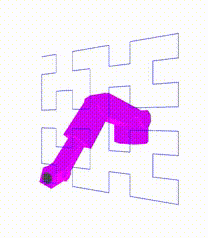
| Sources | https://github.com/tinkerator/saxis |
|---|
This program models a 6 degrees of rotational freedom robot arm using
the sixaxis
kinematics package. The arm renders via a web page using the
three.js rendering API.
To run the program you should do:
$ git clone https://github.com/tinkerator/saxis
$ cd saxis
$ git submodule init
$ git submodule update
$ go mod tidy
$ go build
$ ./saxis
NOTE The git submodule ... parts are to cache a local copy of the
three.js sources that are needed to get the 3D rendering of the
robot to work.
Then you point your web browser at http://localhost:8080 and watch the saxis robot dance a Hilbert curve with the various modes of movement that it supports.
What you see looks like this:

The saxis program cycles through a series of programmed sequences:
program numbers 1, 2, … There are 4 distinct sequences that
endlessly repeat. They deomonstrate the
zappem.net/pub/kinematics/sixaxis
robot motion patterns as follows:
1,5,9,… Joined mode determines the pose for the robot at the
next node of the Hilbert curve and smoothly interpolates all of the
joint angles from the last pose to that pose. It sort of follows the
curve.
2,6,10,… Arc mode subtends an arc of --arc degrees (defaults
to 120) between the nodes of the Hilbert curve. The robot only
intersects the curve at these nodes and otherwise bounces away from
the line.
3,7,11,… Linear mode rigidly follows the actual linear segments
of the Hilbert curve. This motion is the most robotic.
4,8,12,… Near mode is the most fluid motion. It cuts the corners
(nodes) of the Hilbert curve leaving the official line at about
1/7th of the line from each node. It is this program that is
recorded (“OFF AIR” -> “ON AIR”) for later saving via the “SAVE
VIDEO” button. If you click this labeled button, a sample.webm
video file is saved where your browser saves files (and not the
working directory of the saxis program).
This was the setup for the threejs code:
$ git submodule add https://github.com/mrdoob/three.js.git
The various …min.js files from this submodule are symbolically
linked from ./html/js/ locations.
The saxis program is distributed with the same BSD 3-clause license
as that used by golang itself. Viewing
in a browser depends on three.js to render
its image in a browser and that has its own MIT license.
The saxis program was developed purely out of self-interest to try
to understand how robots like this work. Should you find a bug or want
to suggest a feature addition, please use the bug
tracker.